Deacylgymnemic acid
Reference standards.
Inquire / Order:
manager@chemfaces.com
Technical Inquiries:
service@chemfaces.com
Tel:
+86-27-84237783
Fax:
+86-27-84254680
Address:
1 Building, No. 83, CheCheng Rd., Wuhan Economic and Technological Development Zone, Wuhan, Hubei 430056, PRC
Providing storage is as stated on the product vial and the vial is kept tightly sealed, the product can be stored for up to
24 months(2-8C).
Wherever possible, you should prepare and use solutions on the same day. However, if you need to make up stock solutions in advance, we recommend that you store the solution as aliquots in tightly sealed vials at -20C. Generally, these will be useable for up to two weeks. Before use, and prior to opening the vial we recommend that you allow your product to equilibrate to room temperature for at least 1 hour.
Need more advice on solubility, usage and handling? Please email to: service@chemfaces.com
The packaging of the product may have turned upside down during transportation, resulting in the natural compounds adhering to the neck or cap of the vial. take the vial out of its packaging and gently shake to let the compounds fall to the bottom of the vial. for liquid products, centrifuge at 200-500 RPM to gather the liquid at the bottom of the vial. try to avoid loss or contamination during handling.
Nat Prod Sci.2014, 20(3):182-190
Nutrients.2023, 15(3):753.
Molecules.2019, 24(16):E2985
Oxid Med Cell Longev2020, 12
Front Immunol.2024, 15:1423776.
J Food Biochem.2020, 44(6):e13198.
Food Science and Preservation2024, 31(3):486-498.
Molecules.2023, 28(18):6734.
Molecules.2022, 27(22):7887.
Russian J Bioorganic Chemistry 2021, 47:1411-1417.
Related and Featured Products
Evidence-Based Complementary and Alternative Medicine,2018.
In Vitro Antidiabetic Effects of Isolated Triterpene Glycoside Fraction from Gymnema sylvestre.[Reference:
WebLink]
A triterpene glycoside (TG) fraction isolated and purified from ethanolic extract of Gymnema sylvestre (EEGS) was investigated for blood glucose control benefit using in vitro methods.
METHODS AND RESULTS:
The HPLC purified active fraction TG was characterized using FTIR, LC-MS, and NMR. The purified fraction (TG) exhibited effective inhibition of yeast α-glucosidase, sucrase, maltase, and pancreatic α-amylase with IC50 values 3.16 ± 0.05 μg/mL, 74.07 ± 0.51, 5.69 ± 0.02, and 1.17 ± 0.24 μg/mL, respectively, compared to control. TG was characterized to be a mixture of triterpene glycosides: gymnemic acids I, IV, and VII and gymnemagenin. In vitro studies were performed using mouse pancreatic β-cell lines (MIN6). TG did not exhibit any toxic effects on β-cell viability and showed protection against H2O2 induced ROS generation. There was up to 1.34-fold increase in glucose stimulated insulin secretion (p<0.05) in a dose-dependent manner relative to standard antidiabetic drug glibenclamide. Also, there was further one-fold enhancement in the expression of GLUT2 compared to commercial standard DAG (Deacylgymnemic acid).
CONCLUSIONS:
Thus, the present study highlights the effective isolation and therapeutic potential of TG, making it a functional food ingredient and a safe nutraceutical candidate for management of diabetes.
Yakugaku Zasshi : Journal of the Pharmaceutical Society of Japan, 01 Apr 1993, 113(4):316-320.
Quantitative analysis of deacylgymnemic acid by high-performance liquid chromatography.[Reference:
WebLink]
METHODS AND RESULTS:
A method of the quantitative analysis was established for the determination of Deacylgymnemic acid (DAGA) in the alkaline hydrolysate of the sample containing gymnemic acids which are ingredients of Gymnema sylvestre R. BR. leaves, by means of high-performance liquid chromatography. This method was used for comparing the contents of gymnemic acids in various samples. The amount of gymnemic acids analyzed as DAGA in 70% ethanol extract of dry leaves was about twice that in hot water extract.
CONCLUSIONS:
The commercial health-supplemental foods of five companies were investigated for the contents of gymnemic acids as DAGA and there were large differences from 38 to 251 mg in the dosage per day recommended by each company.



